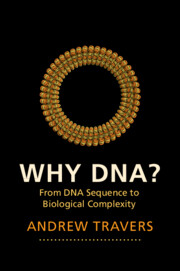Book contents
- Why DNA?
- Frontispiece
- Why DNA?
- Copyright page
- Contents
- Preface
- Acknowledgements
- 1 The Perennial Question
- 2 The Nature of Biological Information
- 3 DNA
- 4 The Evolution of Biological Complexity
- 5 Cooperating Genomes
- 6 DNA, Information and Complexity
- 7 Origins of Complexity
- 8 The Complexity of Societies
- 9 Why DNA
- General Reading and Bibliography
- Index
2 - The Nature of Biological Information
Information, Complexity and Entropy
Published online by Cambridge University Press: 05 May 2022
- Why DNA?
- Frontispiece
- Why DNA?
- Copyright page
- Contents
- Preface
- Acknowledgements
- 1 The Perennial Question
- 2 The Nature of Biological Information
- 3 DNA
- 4 The Evolution of Biological Complexity
- 5 Cooperating Genomes
- 6 DNA, Information and Complexity
- 7 Origins of Complexity
- 8 The Complexity of Societies
- 9 Why DNA
- General Reading and Bibliography
- Index
Summary
Schrödinger’s solution to the question, ‘What is life?’ was to postulate that ‘information’ in the genetic material, characterised as the ‘codescript’, was essential for the thermodynamic minimisation of entropy (Box 1.3) accompanying the increasing organisation of biological systems. This critical insight paved the path for understanding the mechanisms of biological evolution. But how would a ‘codescript’ potentially lead to an increase in organisation? A simple, although not exact, analogy would be a small person given a pile of (appropriate) Lego bricks and asked to build a model of a space rocket. With no knowledge of how the rocket is put together, this would be an essentially impossible, or at the very least highly improbable, task, akin to the thousand monkey scenario (Chapter 1). However, given a book of instructions, such small people would – and, by observation, do – make short shrift of the problem. These instructions thus facilitate the construction of a specific complex structure and in so doing dramatically increase the probability of success. Similarly, without appropriate instructions ‘all the king’s horses and all the king’s men’ failed to put the smashed Humpty Dumpty together again. Again they lacked the information to transform an essentially irreversible event – with its statistically highly improbable reversal – into an organised structure (for an excellent discussion on this point see Penrose [2010]).
- Type
- Chapter
- Information
- Why DNA?From DNA Sequence to Biological Complexity, pp. 20 - 52Publisher: Cambridge University PressPrint publication year: 2022

